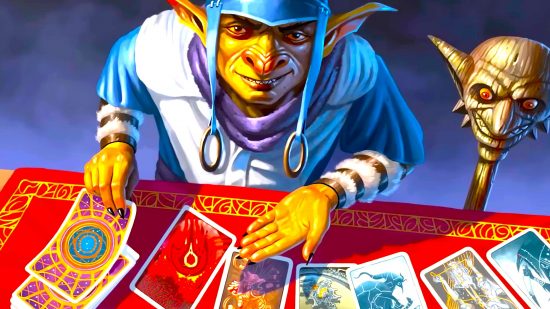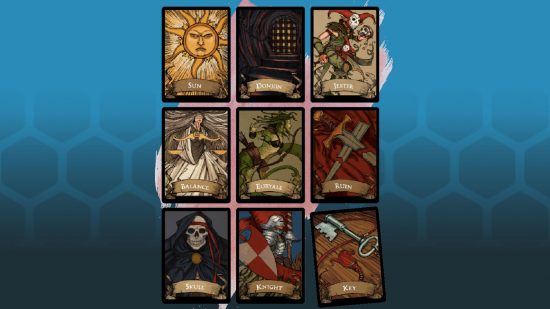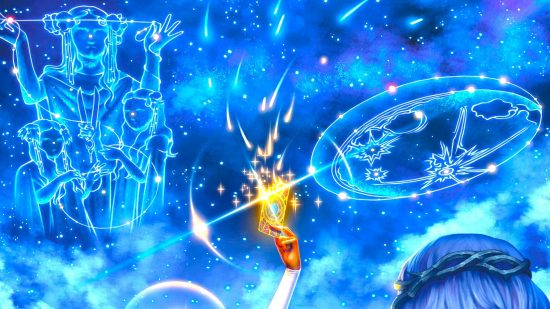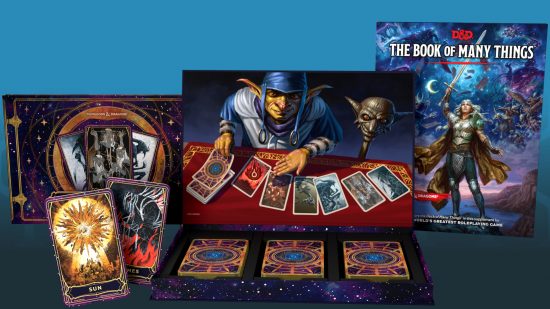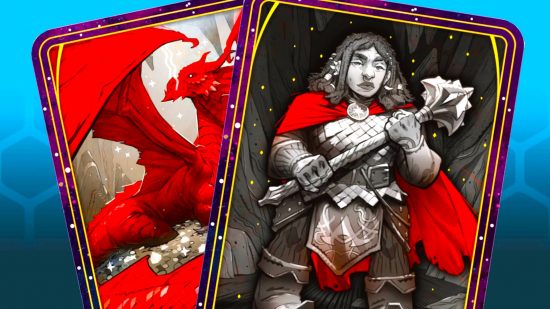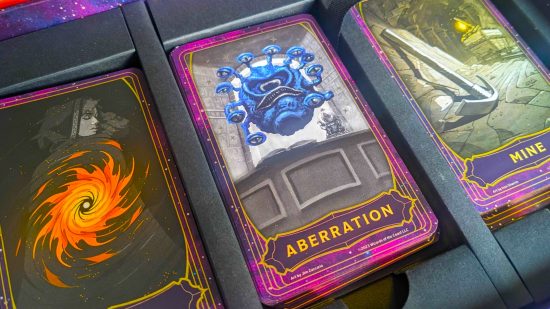The DnD Deck of Many Things is a magical deck of cards with the power to change lives. Drawing a single card may grant your D&D character more riches than they could ever spend – or it could send them to an inescapable hell dimension. That’s how things go when you leave fate up to the luck of the draw.
Below you’ll find the complete history of the D&D Deck of Many Things, including the latest Deck of Many Things 5e includes. Before we reveal the cards, though, we’ve plenty more knowledge to offer a budding Dungeons and Dragons player. We can help you choose the perfect DnD classes and DnD races for your next DnD character build, and we’ve plenty of DnD encounter builder advice for DMs.
For now, though, it’s time to cut the deck:
History of the Deck of Many Things
Publication history
The Deck of Many Things was present in the very first D&D supplement, 1975’s Greyhawk. In its original form, the deck contained 18 nameless cards. These were represented by a selection of ordinary playing cards – the ace, king, queen, and jack of all four suits, plus a single joker.
Next, the Deck of Many Things appeared in the 1979 Dungeon Master’s Guide. This version typically had 13 cards, which corresponded to the king, queen, and jack of each suit in a playing card deck (plus one joker). Plus, each individual card was given a unique name.
The DM’s Guide also mentioned the existence of a rarer, 22-card deck, which added the 2 and ace of each suit and another joker.
These versions of the Deck of Many Things became the staple edition for many years. They featured in the third-edition DM’s Guide published in 1989, as well as 1994’s Encyclopedia Magica Vol. 1. Later, the 22-card version would appear in the DM’s guide for D&D 3e and 3.5e.
In 1983, another Deck of Many Things appeared in issue 77 of Dragon magazine. This was a 78-card deck which was represented by real tarot cards. Several magazine entries from Dragon and Dungeon would expand the lore and look of the deck over the years. The Deck of Many Things was around for fourth edition, but its only major appearance was in the 2011 boxed adventure, Madness at Gardmore Abbey.
Deck of Many Things origin story
Many stories have been told about how the Deck of Many Things came to be. In one telling, the cards were playing cards imbued with minor magic by citizens of the Netheril Empire. The Empire fell, and as the cards were lost to time, their powers grew to enormous heights.
In a more recent story, cards from the deck were originally constellations in the Sky of Many Things. Istus, the DnD god of fate, drew the stars down from the sky and imbued cards with their magical power.
Deck of Many Things 5e
D&D 5e acknowledged the Deck of Many Things in its 2014 DM’s Guide. This edition brought back the thirteen-card version of the deck, and it used art created by William O’Connor for D&D 4e.
Then Wizards of the Coast decided it was time to give the deck a makeover. On November 14, 2023, Wizards of the Coast will release the Deck of Many Things 5e. This new deck features a whopping 66 cards – the 22 original cards, plus 44 cards collectively known as ‘The Deck of Many More Things’.
Along with the new deck, Wizards of the Coast will release a dedicated DnD book titled The Book of Many Things. It updates the lore behind the famous deck, and it offers new ways for players and DMs to use the cards. This includes using the deck to figure out your DnD star sign or randomly generate adventures.
How to use the Deck of Many Things
Drawing cards
If a player wants to draw from the Deck of Many Things, they must state their intent, including how many cards they plan to pull. If a card commands you to, you can pull extra cards from the deck.
Otherwise, failing to state intent before pulling or drawing the incorrect number of cards will render the cards useless. Drawing fewer cards than planned sometimes causes the deck to spit out the remaining cards for you, and their magic takes effect all at once.
Once drawn, a card’s magical effect resolves instantly. If you’ve pulled from the deck before, you must wait an hour before you can do so again.
Apart from the Fool or the Jester, a drawn card reappears in the deck after it resolves. This means it’s possible to draw most cards more than once in a single session.
Deck of Many Things cards
Here are the 22 cards from the Deck of Many Things, as listed in the fifth edition Dungeon Master’s Guide:
| Name | Effect |
| Balance | Your DnD alignment changes to its opposite (chaotic becomes lawful, good becomes evil, and vice versa). If you are neutral or unaligned, there is no effect. |
| Comet | If you single-handedly defeat the next hostile DnD monster or group of monsters you encounter, you gain enough experience points (XP) for a DnD level up. Otherwise, there is no effect. |
| Donjon | You disappear and are trapped in suspended animation in an extradimensional sphere. You leave everything you were wearing or carrying behind, and you are imprisoned until you are found. Divination magic can’t track you, but a Wish spell can reveal your location. You draw no more cards. |
| Euryale | You are cursed and take a -2 pentalty on saving throws. Only DnD gods or The Fates card can end the curse. |
| The Fates | You can undo a single event as if it never happened. You can choose to use the card’s power immediately or at another time before your death. |
| Flames | A devil becomes your enemy and will attempt to ruin your life before it kills you. This rivalry lasts until you or the devil dies. |
| Fool | You lose 10,000 XP, discard this card, and draw from the deck again (both count as one of your declared draws). If you would lose a level, you instead lose an amount of XP that leaves you with just enough to keep your current level. |
| Gem | You immediately receive 25 pieces of jewelry worth 2,000 gold pieces (GP) each – or 50 gems worth 1,000 GP each. |
| Jester | You gain 10,000 XP, or you can draw two additional cards beyond your declared draws. |
| Key | A magic DnD weapon of rare or higher rarity appears in your hands. The DM gets to choose the weapon. |
| Knight | A fourth-level fighter of the same race as you appears within 30ft of you. They will fight for you until their death, and you have control of this character. |
| Moon | You can cast the Wish 5e spell 1d3 times. |
| Puzzle* | Your Intelligence DnD stat is permanently reduced by 1d4 + 1 (minimum of one 1). You can draw one extra card beyond your declared draws. |
| Rogue | An NPC of the DM’s choice becomes hostile towards you. You won’t know their identity until the NPC or someone else reveals it, and only a Wish spell or action from the gods can change how your new enemy feels towards you. |
| Ruin | You lose all wealth you carry or own (apart from DnD magic items). Any proof of ownership (deeds, for example) also vanish. |
| Sage** | At any time within one year, you can ask a question during meditation and receive a truthful answer. As well as information, you receive guidance on how to apply your new knowledge. |
| Skull | An Avatar of Death appears within 10ft and attacks you. The monster claims you must defeat it alone, and it fights until you die or it drops to zero hit points. If anyone tries to help you, the helper gets their own Avatar of Death. Anyone killed by an Avatar can’t be brought back to life. |
| Star | One of your ability scores increases by two. It can be higher than 20, but no higher than 24. |
| Sun | You gain 50,000 XP and a wondrous item. The DM chooses the item at random. |
| Talons | Every magic item you’re wearing or carrying disintegrates. Artifacts vanish instead. |
| Throne | You become proficient in the Persuasion DnD skill, and you double your proficiency bonus for Persuasion checks. You also gain ownership of a keep that’s currently overrun by monsters. |
| The Void | Your soul is taken from your body and stored in an object of the DM’s choosing. Your body is incapacitated, and your prison is guarded by one or more powerful beings. A Wish spell won’t bring back your soul, but it can locate the object that traps it. You draw no more cards. |
* Previously called The Idiot
** Previously called The Vizier
And here are the 44 cards found in the Deck of Many More Things:
| Name | Effect |
| Aberration | You gain telepathy with a range of 90ft. |
| Beast | You immediately transform into a Beast with a challenge rating of five or lower for 2d12 days. Ability scores, hit points, and actions are replaced with the Beast’s stats, and non-magical equipment you have merges with your new form, rendering it unusable. Magic items drop within five feet of your new form. Only a Wish spell can end this effect early. |
| Book | You learn to speak, read, and write 1d6+2 DnD languages of your choice. |
| Bridge | You can cast Time Stop 1d3 times, using Intelligence, Wisdom, or Charisma as your spellcasting ability. |
| Campfire | You immediately gain the benefits of a long rest 5e. |
| Cavern | You gain a climbing speed equal to your walking speed. You can move up, down, and across vertical surfaces and ceilings while leaving your hands free. |
| Celestial | You gain a pair of luminescent feathered wings and a flying speed of 30ft. |
| Construct | A Homunculus appears within five feet of you and treats you as its creator. The DM decides what it looks like. |
| Corpse | You drop to zero hit points, become unconscious, and must begin death saving throws. Spells and magic that restore HP have no effect until you are stabilized. If you fail three death saving throws, you die and can only be resurrected by a Wish spell. |
| Crossroads | Roll a d20. If the result is even, you age 1d10 years (minimum of 1). If the roll is odd, you become 1d10 years younger (minimum of 1). Only divine intervention, a Wish spell, or similar magic can undo the effects. |
| Door | You can cast Gate 1d4 times without material components, using Intelligence, Wisdom, or Charisma as your spellcasting modifier. |
| Dragon | A dragon egg appears in front of you and hatches into a DnD dragon wyrmling. It sees you as its parents and is loyal to your party. The DM chooses what type of dragon it is. |
| Elemental | You become immune to acid, cold, fire, lightning, or thunder damage (your choice). You must choose immediately. |
| Expert | Your Dexterity increases by two, to a maximum of 22. |
| Fey | You’re transported to the Feywild, and you draw no more cards. The fey crossing that pulled you through remains open for one minute after the card is drawn. The DM chooses exactly where in the Feywild you end up. |
| Fiend | A Fiend appears in a nearby unoccupied space and offers you a deal. The DM decides what the deal is, but it typically involves a material reward in exchange for completing a task. The Fiend is indifferent to you and can be bargained with, and it always keeps its side of a bargain (even if it twists your words). If attacked or refused, the Fiend returns to its DnD plane. |
| Giant | You immediately grow 2d10 inches taller, and your hit point maximum and current hit points increase by 20. |
| Humanoid | You can immediately choose to stop drawing from the deck. |
| Lance | All your ability scores increase by one to a maximum of 20. |
| Mage | Your Intelligence increases by two to a maximum of 22. |
| Map | At any time within one year, you can name or describe an object or individual that’s familiar to you, and you’ll immediately know its location and the distance between you. This works even if the target is on another plane. If you named an individual, you learn whether they are alive and what conditions they have. For an object, you learn if it’s broken or not, as well as any charges it has left if it’s magical. |
| Maze | You gain 1d3 levels of exhaustion 5e. |
| Mine | You immediately gain a pile of 2d6 gems worth 5,000 GP each and 1d10 chunks of ore worth 2,500 GP each. |
| Monstrosity | A Large or larger Monstrosity (challenge rating 10 or less, chosen by the DM) appears within 15ft of you. It attacks immediately and disappears when killed or you are reduced to zero HP. If there isn’t room for the creature to appear, the card has no effect. |
| Ooze | A hostile Gelatinous Cube appears in your space and engulfs you. It remains until it is destroyed. If there isn’t room for the monster to appear, the card has no effect. |
| Path | Your walking speed increases by 10ft. |
| Pit | A pit opens beneath you, and you fall 3d6 x 10 ft. You take damage from the fall, and you become prone. |
| Plant | You can cast Speak with Plants once per long rest without using a spell slot. You can cast this with spell slots of level three or higher if you have them. Intelligence, Wisdom, or Charisma is your spellcasting modifier. |
| Priest | Your Wisdom stat increases by two to a maximum of 22. |
| Prisoner | You are restrained by glowing magical chains until you are freed or the chains are destroyed. You can’t cast spells while chained, and your magic items have no effect. The chains are immune to damage and Dispel Magic (or similar magic effects), but Disintegrate or a DC30 Dexterity check using thieves tools can free you. You draw no more cards. |
| Ring | A rare or rarer magic item appears on your finger (the DM chooses what it is). If you have attunement slots available, you automatically become attuned. |
| Shield | A rare or rarer suit of magic DnD armor that you are proficient with appears in your hands. The DM chooses the armor. If you lack proficiency with all armor, your base armor class becomes 12 + your Dexterity modifier while you aren’t wearing armor. |
| Ship | You become proficient in three skills chosen by the DM. |
| Staff | A rare or rarer magic rod, staff, or wand of the DM’s choice appears in your hands. |
| Stairway | You can decrease your number of declared draws by two or receive a rare or rarer wondrous item of your DM’s choice, which appears in your hands. |
| Statue | You immediately become petrified as you’re transformed into marble. This lasts until you are freed by Greater Restoration or similar magic. |
| Tavern | Your Charisma score increases by two to a maximum of 22. |
| Temple | A deity or creature of similar power arrives to help you. At any time between now and your death, you can use an action to call for divine intervention. The parameters and nature of the intervention are chosen by the DM, but the deity is required to answer your call. If you die without using this ability, the deity casts Resurrection on you and considers its tithe paid. |
| Tomb | Any time within one year, you can cast True Resurrection without using a spell slot or material components. Intelligence, Wisdom, or Charisma is your spellcasting modifier. |
| Tower | Draw two extra cards beyond your declared number of draws, and choose one of the two cards to keep and one to return to the deck. Only the chosen card takes effect. |
| Tree | Your skin becomes like bark. As long as you wear no armor, your armor class equals 15 + your Dexterity modifier. You become vulnerable to fire damage. This effect can only be undone by a Wish spell or similar magic. |
| Undead | A Revenant appears on the Material Plane and begins to hunt you, blaming you for its existence. The Revenant exists for a year, until it kills you, or until a Wish spell banishes it. |
| Warrior | Your Strength stat increases by two to a maximum of 22. |
| Well | You learn three DnD cantrips of your choice from any class spell list. |
For more of the latest D&D news, check out our thoughts on the latest tabletop RPG titles. We’ve got a full Planescape 5e review for you to peruse, and our Baldur’s Gate 3 review can tell you more about the greatest DnD game ever made.
